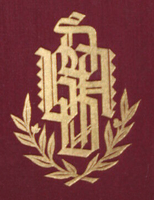German Clothing Workers' Union
The German Clothing Workers' Union (German: Deutscher Bekleidungsarbeiter-Verband, DBAV) was a trade union representing people involved in making clothing in Germany.
 | |
| Native name | Deutscher Bekleidungsarbeiter-Verband |
|---|---|
| Founded | 1 October 1888 |
| Predecessor | Travel Support Association of German Tailors |
| Successor | Textile and Clothing Union |
| Date dissolved | May 1933 |
| Members | 77,884 (1928) |
| Journal | Bekleidungsarbeiter |
| Affiliation | ADGB, ICWF |
| Office location | 15 Wusterhausener Straße, Berlin |
| Country | Germany |
The union was founded in 1888 as the German Union of Tailors. It changed its name frequently until 1894, when it became the Union of Tailors, Dressmakers and Kindred Trades. In 1907, the Union of Lingerie and Tie Workers in Germany merged in, and it renamed itself as the Union of Tailors and Dressmakers in Germany.[1]
After World War I, the union was a founding constituent of the General German Trade Union Confederation. In 1924, it was joined by the German Furriers' Union, and by 1928, it had 77,884 members. In 1933, it was banned by the Nazi government.[1][2] After World War II, the Textile and Clothing Union was formed to represent clothing workers.[3]
Presidents
- 1888: Karl Neißier[4]
- 1890: Friedrich Holzhäußer[4]
- 1903: Heinrich Stühmer[4]
- 1920: Martin Plettl[4]
References
- "Deutscher Bekleidungsarbeiter-Verband" (PDF). Friedrich Ebert Stiftung. Retrieved 27 May 2020.
- Heyde, Ludwig (1931). Internationales Handwörterbuch des Gewerkschaftswesens. Berlin: ADGB. Retrieved 27 May 2020.
- Ebbinghaus, Bernhard; Visser, Jelle (2000). Trade Unions in Western Europe Since 1945. Basingstoke: Palgrave Macmillan. p. 309. ISBN 0333771125.
- Stümer, Heinrich. "Deutscher Bekleidungsarbeiter-Verband". Friedrich Ebert Stiftung. Retrieved 27 May 2020.